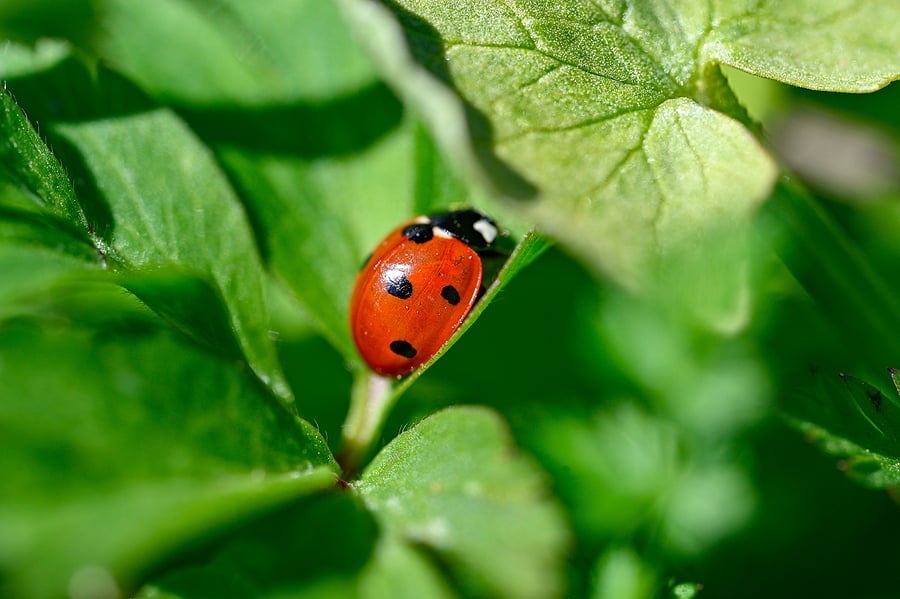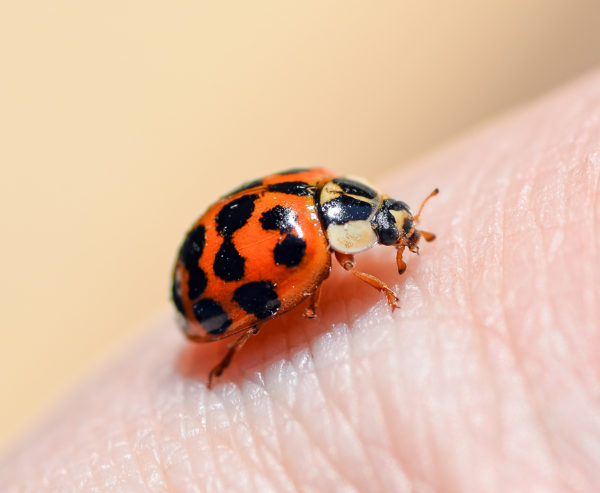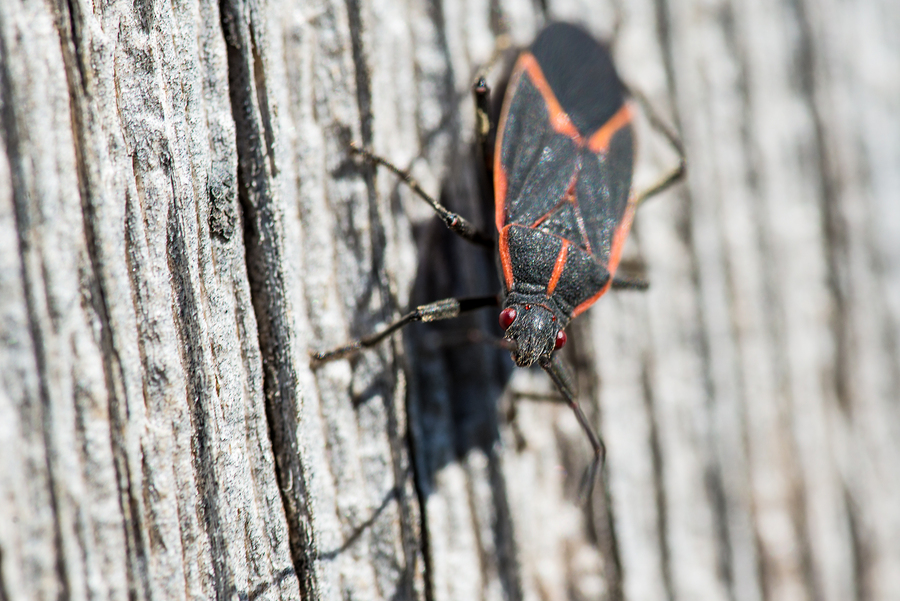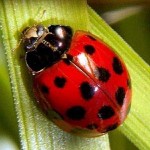READY TO GET STARTED?
REQUEST A FREE ESTIMATE
Fill out the form below or call (888) 466-7849 for a free, no-obligation estimate.

There are over 5000 species of ladybugs worldwide. These insects, also known as ladybird beetles or lady beetles, are common throughout North America. Their appearance varies depending on the species; colors can range from red to orange and they can have spots, stripes, or even no pattern on their dome shaped bodies.
Ladybugs are harmless to humans and are even considered to be good luck in some cultures. They are beneficial to have around as they eat aphids and other plant-eating pests. While they are harmless to us, they can stain walls and furniture in your home and give off an odor.
Ladybugs are most active from spring to fall. Once the weather cools off, they will search for warm, isolated places to overwinter, such as rotting logs, under rocks, or inside our homes. When the weather warms up again, they will emerge from their hiding spots, seemingly taking over the homes they infested.
You can get rid of ladybugs by:
If you have an issue with ladybugs or other household pests, contact your local pest control company for a free evaluation.

When we think of winter pests we usually think of squirrels, raccoons, rodents, and spiders. Ladybugs aren’t usually at the top of our list, but they are one of the most common winter pests. During the warmer months of the year, ladybug populations grow as they feed on the foliage and aphids. With the onset of colder weather, these food sources diminish, forcing them indoors in search of food and warmth. Ladybugs will seek shelter under rocks, leaves, and timber, and inside buildings and homes.
Ladybugs aren’t considered a threat to humans. However, they have been known to cause allergic reactions in some people and aggravate asthma. They also give off a smelly, yellow colored fluid that stains anything it comes in contact with.
The best way to prevent ladybugs is to eliminate ways for them to get into your home. Make sure the cracks around your windows, doors, siding and utility pipes are sealed. You can use a silicone or silicone-latex caulk to seal. Repair and replace damaged screens on both windows and doors. If you already have ladybugs in your home, the best way to get rid of them is with a vacuum cleaner. Empty the vacuum bag into a trash bag and seal it tightly and dispose of it outside immediately. If you suspect you have a ladybug infestation, contact a professional pest control company to provide you with a thorough evaluation and treatment plan.

As the temperatures start to drop, overwintering pests start making their way indoors. Although these pests are considered to be beneficial, they become a nuisance when moving into your home in overwhelming numbers.
The two most common overwintering pests are boxelder bugs and ladybugs (ladybird beetles). Here’s what you need to know about each one and how you can prevent & get rid of them:
Boxelder and silver maple trees serve as the spring and summer hosts for boxelder bugs (shown above). In the winter, they migrate by the hundreds and thousands out of these trees and begin to congregate on the south side of buildings and homes. After reaching a large enough population, they may fly off to nearby sites to hibernate for winter, or try to enter the structure they have congregated on.
To prevent boxelders bugs from infesting your home, use similar exclusion methods mentioned above, making sure entry points are sealed. If you’re already seeing boxelders inside, the best way to remove them is with a vacuum.
To control a boxelder invasion, professional pest control methods have proven to be effective when infested trees and the surrounding areas are treated with a residual product, along with treatments on the sunny/south side of the home’s exterior.

Ladybugs are very beneficial insects; they protect our plants by feeding on aphids, mites, scale insects, and their eggs. But with the onset of winter and colder temperatures, large amounts of ladybugs start invading homes, making them more of a nuisance pest. To prevent this, simple home exclusion – sealing around windows and doors, replacing broken screens, and caulking around the open voids around electrical and plumbing entry points – can be effective. You can also caulk above windows and doors on the inside of the home, as ladybugs tend to emerge from these areas often. For added preventative protection, consider contacting a pest control company. Exterior treatments can be effective if done before ladybugs are seen indoors. (Treatment inside is not recommended once there’s a problem because the products kill/trap the ladybugs in wall voids which attracts carpet beetles and larder beetles.)
If you’re already seeing ladybugs indoors, remove them carefully being careful not to squish them; they produce a yellow, foul smelling defensive liquid that may stain whatever it comes in contact with. Below are two pictures showing a larva Ladybug (left) and what the overwintering adult (right) look like.


As the temperatures start to drop, overwintering pests start making their way indoors. Although these pests are considered to be beneficial, they become a nuisance when moving into your home in overwhelming numbers.
The two most common overwintering pests are boxelder bugs and ladybugs (ladybird beetles). Here’s what you need to know about each one and how you can prevent & get rid of them:
Boxelder and silver maple trees serve as the spring and summer hosts for boxelder bugs (shown above). In the winter, they migrate by the hundreds and thousands out of these trees and begin to congregate on the south side of buildings and homes. After reaching a large enough population, they may fly off to nearby sites to hibernate for winter, or try to enter the structure they have congregated on.
To prevent boxelders bugs from infesting your home, use similar exclusion methods mentioned above, making sure entry points are sealed. If you’re already seeing boxelders inside, the best way to remove them is with a vacuum.
To control a boxelder invasion, professional pest control methods have proven to be effective when infested trees and the surrounding areas are treated with a residual product, along with treatments on the sunny/south side of the home’s exterior.

Ladybugs are very beneficial insects; they protect our plants by feeding on aphids, mites, scale insects, and their eggs. But with the onset of winter and colder temperatures, large amounts of ladybugs start invading homes, making them more of a nuisance pest. To prevent this, simple home exclusion – sealing around windows and doors, replacing broken screens, and caulking around the open voids around electrical and plumbing entry points – can be effective. You can also caulk above windows and doors on the inside of the home, as ladybugs tend to emerge from these areas often. For added preventative protection, consider contacting a pest control company. Exterior treatments can be effective if done before ladybugs are seen indoors. (Treatment inside is not recommended once there’s a problem because the products kill/trap the ladybugs in wall voids which attracts carpet beetles and larder beetles.)
If you’re already seeing ladybugs indoors, remove them carefully being careful not to squish them; they produce a yellow, foul smelling defensive liquid that may stain whatever it comes in contact with. Below are two pictures showing a larva Ladybug (left) and what the overwintering adult (right) look like.

 There are more than 5,000 different ladybug species in the world, known by many different names. Ladybird beetles, lady beetles, ladybirds, God’s cow, lady clock, lady cow, lady fly..these are just to name a few. The easiest way to tell a ladybug from another insect is their appearance: their bodies are always a round or oval dome-shape, they have a hard shell wing that covers their inner wings, and they are able to retract their head like a turtle.
There are more than 5,000 different ladybug species in the world, known by many different names. Ladybird beetles, lady beetles, ladybirds, God’s cow, lady clock, lady cow, lady fly..these are just to name a few. The easiest way to tell a ladybug from another insect is their appearance: their bodies are always a round or oval dome-shape, they have a hard shell wing that covers their inner wings, and they are able to retract their head like a turtle.
Ladybugs leave their summer feeding grounds in fields, forests, and yards and begin to appear indoors in the fall looking for a place to spend the winter. Children love ladybugs because they are easy to catch and they are bright in color. Gardner’s also enjoy them and consider them useful as they eat aphids or insects. Many cultures consider ladybugs lucky and in many countries the sight of a ladybug is either a call to make a wish or a sign that a wish will soon be granted. Ladybugs are the state insect of Delaware, Massachusetts, New Hampshire, New York, Ohio, and Tennessee. They are the official national mascot for the Alpha Sigma Alpha sorority in the United States and the mascot of a ski resort in Spain.
Barry Teubert
Northwest Exterminating
Savannah Service Center Manager
[email protected]